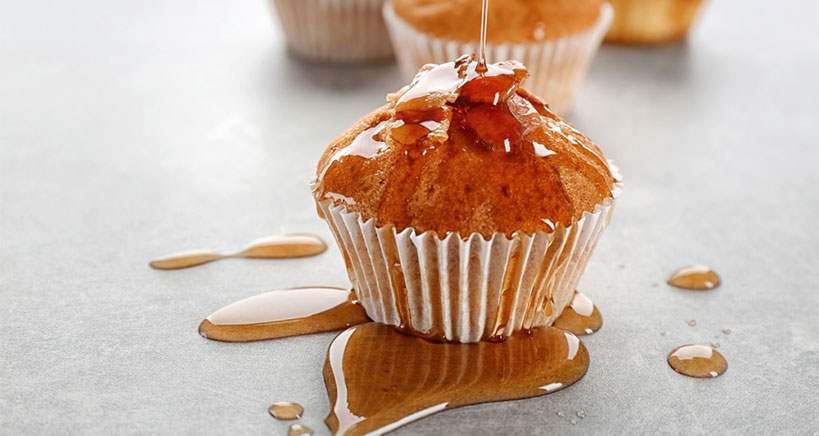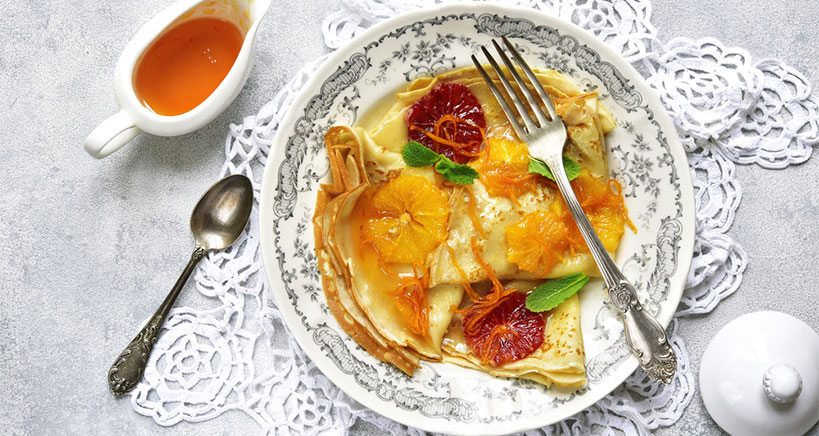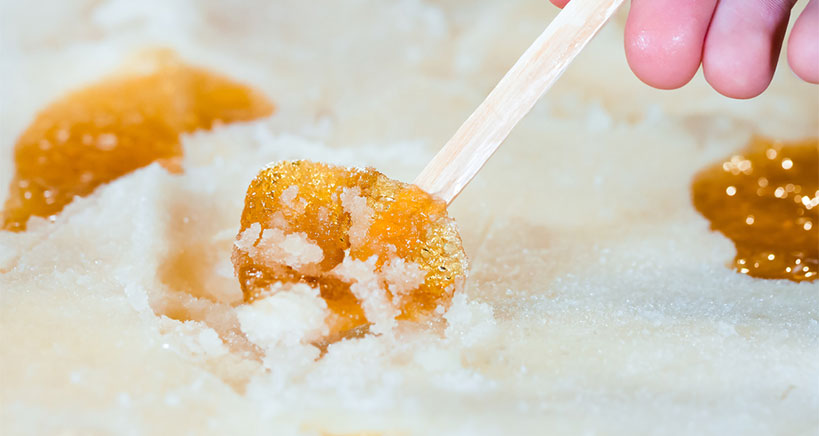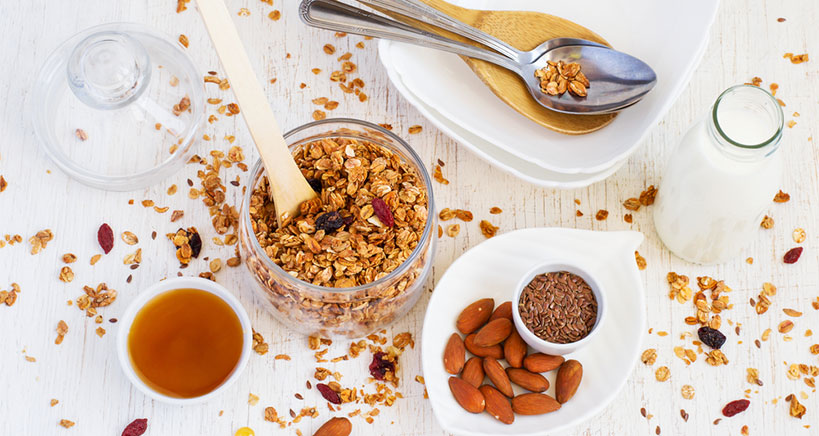
Maple season is back and with the falling of the leaves comes a great opportunity for your catering service, bakery, or restaurant to add maple’s sweet flavor to your customers’ favorite dishes. And if your current use of maple still falls within the ‘maple-syrup-on-pancakes-waffles-and-French toast’ paradigm, it’s time to update your recipe repertoire to maximize maple’s full palate-pleasing potential.
Maple Beyond the Pancakes
With maple’s popularity on the rise, global markets are soaring with new products such as organic maple waters that are being used as flavoring agents in foods or as a replacement for liquids called for in recipes. Meanwhile, chefs around the world are dabbling in adding the natural sweetener to sauces, toppings, desserts (think maple pecan coffee cake smothered in vanilla ice cream drizzled with maple syrup…), baked goods, energy drinks, and even cocktails.
And there is no reason to limit your offerings to the autumn season. If you take a look at what some of the big guns in the ‘biz are up to, consumers have been literally lapping up Dunkin’s year-round maple-pecan flavored coffees and lattes (including both hot and cold brews) and they can now enjoy Oreo’s new Maple Cream cookies, featuring two golden cookies filled with a syrupy sweet maple-flavored crème.
About Maple Syrup
A super-versatile ingredient that you can add to a wide variety of recipes and dishes, maple syrup derives predominantly from the sugar maple tree, the black maple tree, and the red maple tree. The trees are tapped for sap by drilling a hole into their trunk where the exuded sticky substance is collected. Next, it is boiled to make maple syrup, a process during which most of the water evaporates, leaving behind the final concentrated product.
Alternatively, if the sap is heated for longer, it can be made into maple taffy, maple sugar, and maple butter or cream. And for the fact-finding and curious chefs and caterers among you, here is a tasty bite of maple trivia to share with your customers: It takes 40 liters of tree sap to make 1 liter of syrup!

Maple Syrup History
So how and when did this sweet story begin? Historically, the indigenous people of North America were the first to make and use maple syrup, followed by European settlers who refined their methods of production. By the 1970s, technological advances perfected the process even further, giving rise to the types and quality of products manufactured today. Until the 1930s, the United States was the dominant producer in the field, however it is now Quebec, Canada, that takes the top spot, producing more than 80% of the world’s maple syrup, which is estimated to be over 73 million kilograms. Of Quebec’s exports, 64% goes to the United States, and in the United States, Vermont is the largest maple producer, followed by New York and Maine.
New Ways of Adding Maple Syrup to Your Menu
You might be wondering: Why the surge of maple syrup mania in the food and beverage ‘biz? According to some experts, much of the industry’s growth can be attributed to rising consumer demand for all-natural sweeteners and for better-flavored and healthier products. And the trajectory is not expected to slow down any time soon as market analysts forecast a significant growth period for the product from now until 2022.
If you own a bakery or work in the catering business, you will want to include maple’s in-demand sweet flavor in the baking of breads, rolls, muffins, cakes, and wedding cakes. Other ways to incorporate the syrup in recipes is to add it to hot oatmeal and porridges, fresh fruit, applesauce, granola, fritters, baked beans, sweet potatoes, winter squash, pies, tea, coffee, and assorted confectionaries.
‘Maple-Flavored’ versus Organic Maple
If you work in foodservice, it is especially important to learn to discern between imitation syrups (labeled ‘maple flavored,’ ‘pancake syrup,’ or ‘table syrup’) and the real deal. While less expensive than genuine maple syrup, these imitation products are thicker and contain very little maple. Instead, they are flavored with high-fructose corn syrup.
Furthermore, given today’s environmentally concerned customers and their interest in clean labels and all-natural foods and drinks, your eatery would do well to shy away from commercially processed products and invest in delicious, authentic maple.

Update Your Beverage Offerings with Maple Water
Anyone who works in the ‘biz knows that the post-millennium beverage landscape has radically changed with the introduction of drinks hitherto unheard of. No matter what type of foodservice you operate, chances are your beverage menu has expanded to include at least some of the following: nootropic (brain-boosting) beverages, collagen or beauty-enhancing drinks, fermented and probiotic selections, protein drinks, cold brews, mocktails, exotic fruit-flavored drinks (think yuzu, blood orange, and ugly…), energy drinks, smoothies, kombuchu teas, and a rapidly growing selection of bottled water varieties.
And when it comes to bottled water, recent innovations include vitamin-infused, mineral-infused, protein-infused, alkaline-infused, sparkling, and carbonated varieties. You can now add to this list one the newest kids on the block, which is quickly gaining in popularity: Maple Water.
What is Maple Water?
At its essence, maple water is pure maple sap (tapped directly from the tree) that is infused with nutrients. It naturally contains electrolytes, antioxidants, and prebiotics and is even more hydrating than plain water. As opposed to the very sweet flavor associated with maple syrup, it has only a hint of maple taste. In the words of Kate Weiler, cofounder of Drink Maple: “People think maple water is going to overly sweet but are pleasantly surprised by its refreshing quality.”

Purely Organic
Certified USDA organic, most maple waters are also certified non-GMO, meaning that the trees they come from are grown without the use of synthetic pesticides or fertilizers and in a way that protects the quality of the soil. In the case of many maple water producers, not only are the trees carefully hand-selected, but the owners often become stewards of their own part of the woods, ensuring that their trees grow strong and healthy. Healthy trees not only make better sap, they make more of it.
Maple Water Products
As you update your beverage inventory to include maple water, keep your eyes out for new products you can offer your customers, such as flavored iced teas made with maple water and maple water sports drinks.
You can also pitch your new offerings as companions to your customers’ daily morning workouts or late-night power sessions and market maple water as the perfect partner for health-conscious consumers, given that it is naturally sweet, gluten-free, dairy-free, soy free, fat-free, vegan, non-GMO, Kosher, recyclable, and renewable.
There are also a growing number of food items where maple water is a primary ingredient, such as maple cream and maple vinegar. And if you work as a bartender or own a brewery, you may have already noticed a spike in maple-flavored cocktails. In fact, there are a host of new mixed drinks being crafted that include a shot of maple water, such as maple water Manhattans and martinis.
In Sweet Summary
For the foreseeable future, maple is here to stay. So, treat your customers to the sweet taste of maple, maple syrup, and maple waters and enjoy experimenting with creative new recipes. In the words of one consumer: It’s all for the love of maple!